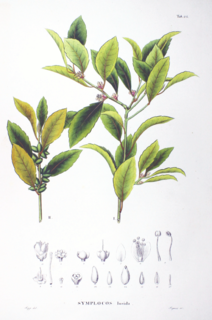
Lygodactylus is a genus of diurnal geckos with approximately 60 species. They are commonly referred to as dwarf geckos. They are mainly found in Africa and Madagascar although two species are found in South America. Lygodactylus picturatus, the best known species, is found in Kenya and commonly known as the white-headed dwarf gecko. Recently, illegal importation from Tanzania of brightly colored, Lygodactylus williamsi, known as electric blue geckos, has been gaining attention for Lygodactylus geckos in the reptile trade.

Symplocos is a genus of flowering plants in the order Ericales. It contains about 300 species distributed in Asia and the Americas. Many species grow in humid tropical regions. This is sometimes considered to be the only genus in family Symplocaceae. Plants in this family are shrubs and trees with white or yellow flowers.
Symplocos anamallayana is a species of plant in the family Symplocaceae. It is endemic to India.
Symplocos bractealis is a species of plant in the family Symplocaceae. It is endemic to Sri Lanka.
Symplocos canescens is a species of plant in the family Symplocaceae. It is endemic to Ecuador. Its natural habitat is subtropical or tropical moist montane forest.
Symplocos coccinea is a species of plant in the family Symplocaceae. It is endemic to Mexico. It is threatened by habitat loss.
Symplocos cordifolia is a species of plant in the family Symplocaceae. It is endemic to Sri Lanka.
Symplocos costata is a species of plant in the family Symplocaceae. It is endemic to Sumatra. It is a vulnerable species threatened by habitat loss.
Symplocos fuscata is a species of plant in the family Symplocaceae. It is endemic to Ecuador. Its natural habitat is subtropical or tropical moist montane forest.
Symplocos molinae is a species of plant in the family Symplocaceae. It is endemic to Honduras.
Symplocos octopetala is a species of evergreen woody plant with small white flowers in the family Symplocaceae. It is endemic to Jamaica. First described in 1788, the most recent concept of the species includes three taxa described as separate species in the late 19th and early 20th century.
Symplocos oligandra is a species of plant in the family Symplocaceae. It is endemic to India. It is threatened by habitat loss.
Symplocos peruviana is a species of plant in the family Symplocaceae. It is endemic to Peru.
Symplocos sousae is a species of plant in the family Symplocaceae. It is found in Costa Rica and Mexico.
Symplocos truncata is a species of plant in the family Symplocaceae. It is endemic to Ecuador. Its natural habitat is subtropical or tropical moist montane forest.

Symplocaceae is a family of flowering plants in the order Ericales, including two genera, Symplocos and Cordyloblaste, totalling about 260 known species. The common name for Symplocaceae is sweetleaf. Symplocaceae has a transpacific distribution that covers the Southeast United States, South America, Southeast Asia and Northern Australia. Plants in the family Symplocaceae are generally trees or shrubs, and are found in humid, tropical, montane forests within their range.
The Antioquia brush finch is a poorly known species of bird from the Passerellidae family. It was scientifically described in 2007 on basis of three museum specimens from Antioquia, Colombia, which were previously labelled as slaty brush finches. The specific epithet blancae refers to the whitish underparts of the new species, while also commemorating the Colombian lepidopterologist Blanca Huertas, the wife of ornithologist Thomas M. Donegan. All three museum skins were collected in the 20th century, but only one label has a date, which is given as 1971. Subsequent fieldwork in Antioquia has failed to find this species again. The species description has been approved by the South American Classification Committee. It has been recommended for a critically endangered status.

Lygodactylus blancae is a species of gecko endemic to Madagascar.

Symplocos tinctoria is a deciduous or evergreen shrub or tree. It is recognized by pith of twigs chambered; by foliage not notably aromatic when bruised, leaves finely hairy beneath. Shrubs or trees to 17 m tall by 36 cm DBH. The largest first-year twigs are under 3 mm across, terminal buds with acute tip, scales ciliate. Leaves are 7–15 cm long, margin entire or occasionally some teeth on the apical half, with a sweet taste that may be faint in old leaves. It is conspicuous when in flower; flowers opening before new leaves develop, fragrant, in clusters from axils of previous year's leaves or from just above the leaf scars if the leaves have fallen; the petals are creamy yellow to yellow, with one pistil. Fruits nearly cylindrical to ellipsoid drupes 8–12 mm long, with thin pulp and a hard stone containing 1 seed; the tip usually retaining parts of the sepals. Foliage is relished by browsing wildlife. A yellow dye may be obtained from bark and leaves. It flowers Mar to May.
Mesopsocus blancae is a species of Psocoptera from Mesopsocidae family that is endemic to Spain.




